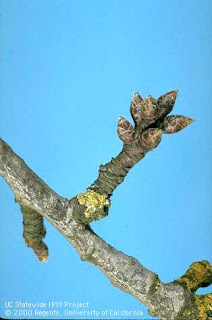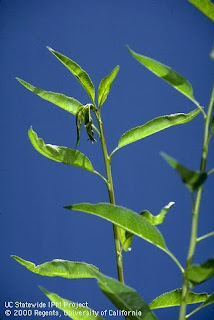The Seasonal Patterns of Almond Production
When reviewing previous posts of this blog, I realized that not much information has been provided about the general biology of the almond tree. To cover this area, I decided to focus on the seasonal cycle of almond trees.
In general, the season progresses in the following pattern: Dormant,Delayed Dormant, Bloom, Post-Bloom, Fruit Development, Harvest, and Post Harvest. Each period will be broken down and discussed.
Dormant:
As the temperatures from the late fall continue to drop, the tree enters a period of rest that lasts through December/Early January. At this time, the tree has dropped all of its leaves naturally or through an application of zinc, and is maintaining a low level of water use and starch consumption. This "low" flow of starch through the tree is needed as the catabolic breakdown of starch to sugar prevents the sap from freezing. This is, of course, only if the tree was able to develop enough starch reserves in the previous fall. In the rare occasion of low starch reserves, cold damage can occur leading to canopy and scaffold loss.
The cold temperatures that the tree is exposed to at this time helps with the development of the fruit buds. The tree requires a certain amount of moisture and chilling hours to come out of dormancy. Once the chilling hour requirement has been met, bud grown will begin with warmer temperatures. Chill hours are dependent upon the variety,but almonds generally need between 500 and 600 chill hours. In general, chill hours are the number of hours between the temperatures of 32-45 degrees Fahrenheit. Winter hours above 60 degrees are subtracted from the totals.
Delayed Dormant:
In late January/early February the tree begins to push a flush of fine feeder roots. These roots provide moisture and nutrients for the future development of leaf and fruit bud. Roots will generally only grow where there is soil moisture, so it remains important that efforts are made to ensure a full soil-water profile if inadequate winter rains have fell. The soil-water profile will be discussed in a later blog about irrigation management.
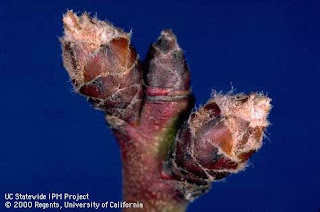
Picture 2: The delayed dormant period is initiated upon the observance of swelled fruit buds.
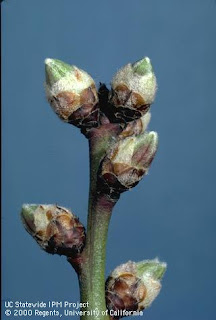
Picture 3: The delayed dormant period is concluded upon the appearance of green tipped buds.
Delayed dormancy is described as the period of fruit bud swell (Picture 2) until the green tip (picture 3). During this period, preparations for bloom occur which include insect and disease management, orchard floor management, and completion of orchard sanitation. Please see the UC Integrated Pest Management (IPM) page on Dormant season practices at http://ucipm.ucdavis.edu/PMG/C003/m003dcwhydormant.html.
Bloom:
Flower buds begin expanding ahead of leaf and shoot buds around Mid-February to Mid-March. Flower buds are formed on at least one year old growth and can be found on the terminal bud of spur or shoot, as well as the lateral buds of a one year old shoot. The timing of the bloom is dependent upon the variety which is related to the amount of chilling hours received. In years of low chilling hours, the bloom period lasts longer and is more sporadic leading to poor pollination. Later blooming varieties are generally more affected by insufficient winter chilling. Keep in mind that even though more chilling hours are needed for later blooming varieties, they are less susceptible to crop damage from early season frost events.
Bloom occurs in a series of flowering stages which are as follows: green tip (Picture 3), pink bud (Picture 4), popcorn stage(Picture 5), full bloom (Picture 6), petal fall (Picture 7), and post-petal fall. Almonds, which are self-incompatible, need to be cross-pollinated with a compatible variety. Insects move the pollen from tree to tree - with honey bees being the insect of choice and efficiency in commercial orchards. Therefore, during bloom, at least two compatible varieties must be in bloom simultaneously for a successful pollination event to occur. To ensure a successful pollination, many growers plant a pollinator that blooms slightly before and slightly after the variety of choice, nonpareil.
During the bloom period, the new leaves emerge from the vegetative buds and the production of carbohydrates occurs through the process of photosynthesis. At this point, growth is no longer dependent upon the reserves of the tree produces from the following year.

Picture 4: Pink bud stage of blossom development.

Picture 5: Popcorn Stage of blossom development.

Picture 6: Full bloom of an almond blossom.
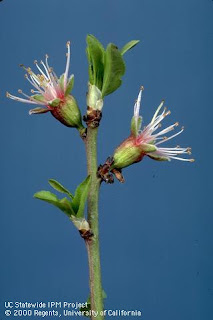
Picture 7: Petal fall period of an almond blossom.
The bloom period contains several important periods of pest and disease management which can be found at http://ucipm.ucdavis.edu/PMG/C003/m003bcwhybloom.html. Poor pest management practices during this period can lead to a substantial crop loss, loss of fruiting wood, and fungal problems that may persist for several years. Of major concern include the blossom diseases of brown rot, scab, anthracnose, and jacket rot, the insect peach twig borer (Picture 8 and 9) and completion of sanitation practices for navel orange worm.
Picture 8: Peach twig borer larvae on an almond blossom.
Picture 9: Damage to a young almond shoot by the peach twig borer.
Fruit Development:
After bloom, a period of rapid vegetative and fruit growth occurs. Hull and shell growth and development continues until May. During this period, the potential size of the fruit is established. Fruit size is dependent upon the vigor of the tree and the number of fruit on each spur - the more fruit on a spur, the smaller the average nut size. Some fruit may fall from the tree through a natural thinning process. This is often called "June Drop," which often occurs in May.
During April, the produced photosynthate is directed toward both shoot and fruit growth. These processes compete with each other for nutrients and water, and thus can be reduced by nutrient deficiencies and/or water stress. In late April, the fruit reaches full size, the inner shell begins to harden, and the outer shell remains soft. In some cultivars, growth stress at this time can disrupt the nut and shell development leading to kernal loss or reduced quality.
In May, the embryo begins to enlarge. This process takes considerable time and will last until June. The embryo is surrounded by a clear and watery embryo sac, called a nucellus. The nucellus is often referred to as jelly. At the tip of the nucellus, a small translucent tissue is present - this is the endosperm. Within a few weeks, the white embryo will appear and will eventually filling the entire shell. Moisture stress or disease may interfere with this process leading to an aborted or shriveled kernal.
By June, kernal fill is complete, and weigh accumulation begins. Since weight is reliant upon the amount of carbohydrates within the kernal, good water management is needed to maintain the highest level of photosynthetic productivity. Water stress during this period can lead to low quality and reduced nut kernal weight. Hardening of the shell is completed in late June/early July.
Fruit maturation is signaled by the occurrence of hull split. Hull split is defined as the separation of the nut along the suture line and the separation of the hull from the shell. There are 4 different periods of hull split, in which the hull goes from a slight abscission along the suture to a point in which the hull is completely separate from the shell. At the same time of hull split, an abscission layer is forming at the base of the hull and spur. This layer will allow for the nut to fall from the tree when the tree is shaken. Hull split requires careful moisture management. Too little water and the abscission layer will not form properly, leading to a large amount of stick tights. Too much water can lead to an over vigorous tree that delays the formation of the abscission layer. Also too much water can lead to over-succulent hulls which are then susceptible to hull rot - a disease caused by fungi that invades the hull tissue.
Hull split does not always occur evenly and may take up to 3-4 weeks. This period of the almond is susceptible to many pests including the insect navel orange worm - which lays its eggs along the suture. The egg then hatches, and the larvae crawls into the shell, eating the kernal (Picture 10), and spreading the fungus Aspergillus flavus, which produces the mycotoxin Aflatoxin - a major regulatory concern. A section on Navel Orange Worm control will be covered in a later blog.
Picture 10: Damage to an almond kernal by the insect navel orange worm.
Harvest:
Harvest should begin on the almond tree when 95-100% of the hulls have split. This period varies from year to year, but usually begins in mid-August. The almond trees are shaken and the nuts fall to the ground. Once on the ground, the hulls will dry if conditions are favorable. An early harvest can reduce the incidence of damage caused by navel orange worm, but can increase the incidence of ant damage. Therefore it is important to employ proper season long pest management practices.
Almond harvest mainly performed by machines. With the exception of young trees, almond trees are mechanically shook (Picture 11), the nuts wind-rowed, and mechanically harvested (picked-up) (Picture 12) by a series of machines. The use of machines has reduced the reliance upon labor and has increased the efficiency of almond production.

Picture 11: An almond shaker removing the nuts from and almond tree.
Picture 12: An almond harvester picking the nuts up off of the ground.
Post-Harvest:
While the fruit are maturing on the tree during the summer, the tree is also developing buds for the next years crop.Shoot bud initiation occurs in April-May, and enters into a period of dormancy from June-Mid August. After harvest, the buds in the leaf axils begin to differentiate into flower buds, while others remain as vegetative buds. During this period of bud differentiation, a severe stress such as a water stressed caused defoliation, can cause the developing buds to push out. This can negatively affect the next years crop. Once into October, however, these buds enter a period of dormancy and will not push until the required chilling hours are met.
In the fall, the tree begins to store the sugar produced through photosynthesis as starch to be used for next year's spring growth flush. The tree also reduces its total moisture content and begins to synthesize the needed proteins for the dormant period.
For more information regarding season long pest management practices for almonds, please see http://ucipm.ucdavis.edu/PMG/selectnewpest.almonds.html.
References used for blog:
Almond Production Manual. 1996. University of California: Agricultural and Natural Resources. Publication 3364.
Integrated Pest Management for Almonds, 2nd Edition. 2002. Statewide Integrated Pest Management Project. University of California: Agricultural and Natural Resources. Publication 3308.
nqcs8af7ty

